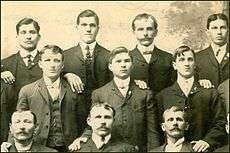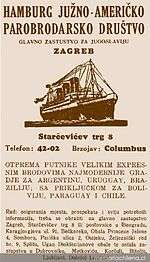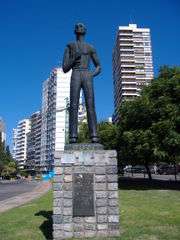Croatian diaspora
| Part of a series on |
| Croats |
|---|
 |
|
Subgroups |
Croatian diaspora refers to the Croatian communities that have formed outside Croatia. Estimates on its size are only approximate because of incomplete statistical records and naturalization, but (highest) estimates suggest that the Croatian diaspora numbers between a third[1] and a half[2] of the total number of Croats.
More than four million Croats live in Croatia. The largest community outside Croatia are the Croats of Bosnia and Herzegovina, one of the constitutient nations of that country, amounting to about 750,000.
The Croatian diaspora outside Croatia and Bosnia and Herzegovina amounts to close to a million elsewhere in Europe, and to about 1.5 million overseas. The largest overseas community is reported from the United States and Chile, with about 400,000 members.
In Western Europe, the largest group is found in Germany. The German census reports 228,000 Croats in Germany as of 2006, but estimates of the total number of people with direct Croatian ancestry (including naturalized German citizens) range as high as 450,000.
Croats of Bosnia and Herzegovina

Croats form one of the three constitutient nations in Bosnia and Herzegovina. They are frequently referred to as Bosnian Croats, but since the War in Bosnia and Herzegovina the number of Herzegovinian Croats exceeds the number in Bosnia. The Croats maintain an unofficial capital in Mostar, with the city being home to the largest Croatian population.
There is no precise data regarding Bosnia and Herzegovina's population since the last war. The UNHCR conducted an unofficial census in 1996, but the data has not been recognized. Ethnic cleansing within Bosnia and Herzegovina in the 1990s saw the vast majority of Croats move and take up residence in the Federation of Bosnia and Herzegovina. It is estimated that there are approximately 600,000 Croats in Bosnia and Herzegovina. According to 2000 data from the CIA World Factbook, Bosnia and Herzegovina is ethnically 14.3% Croat.[3]
Statistics
Europe
- Balkans
- Western and Central Europe
 Germany 227,510 (see Croatian German)[8]
Germany 227,510 (see Croatian German)[8] Austria 150,719[9]
Austria 150,719[9] Switzerland 40,484 (2006)[10]
Switzerland 40,484 (2006)[10] France 30,000 (est)[11]
France 30,000 (est)[11] Hungary 25,730[12]
Hungary 25,730[12] Italy 21,360[13]
Italy 21,360[13] United Kingdom 6,992 (2001 UK Census)[14]
United Kingdom 6,992 (2001 UK Census)[14]
- Scandinavia
Overseas
- Africa
 South Africa 8,000[18]
South Africa 8,000[18]
- North America
 United States 420,763 (2007)[19]
United States 420,763 (2007)[19] Canada 114,880[20]
Canada 114,880[20]
- South America
 Chile 380,000[8]
Chile 380,000[8] Argentina 250,000[8]
Argentina 250,000[8] Bolivia 50,519
Bolivia 50,519 Brazil 45,000 (est)[8]
Brazil 45,000 (est)[8] Peru 6,000
Peru 6,000 Colombia 5,800 (est)[8]
Colombia 5,800 (est)[8]
- Oceania
 Australia 118,046 (2006)[21]
Australia 118,046 (2006)[21] New Zealand 2,550[22] - 100,000(est.)[23]
New Zealand 2,550[22] - 100,000(est.)[23]
Communities
United States

According to the 2005 US census, there are 401,208[24] Americans of full or partial Croatian descent.
First Croatians in Detroit appeared around 1890, settling usually in the region of Russel. In Illinois the Croatians started concentrating mostly around Chicago. Although it was created a bit later, the Croatian settlement in Chicago became one of the most important ones in the United States.
The settlement especially started developing after World War I and Chicago became the center of all Croatian cultural and political activities. It is calculated that there were roughly 50,000 Croats in Chicago in the 1990s, while there were altogether 100,000 Croats living in 54 additional Croatian settlements in Illinois. There is a significant Croat population also in Indianapolis that settled during the Yugoslav Wars of the 90's.
Pittsburgh has always had a sizeable Croatian population. The headquarters of the Croatian Fraternal Union (CFU) - the oldest and largest Croatian organization in the United States - is located in the eastern suburb of Monroeville, PA, established in 1880's. The CFU publishes a weekly newspaper "The Zajednicar Weekly" in both English and Croatian. Most of the Croatians in Pittsburgh originally settled in the early 1900s on the city's North Side. A neighborhood centered on East Ohio Street along the Allegheny River between Millvale and the North Shore was named Mala Jaska after an area in Croatia (northwest of Zagreb).
Canada
The Croatian community is present in most major Canadian cities, including the Greater Toronto Area, Hamilton, Ottawa, Vancouver, Calgary, Windsor, and Montreal.
Some of the more popular Croatian Canadian events are the Croatian-North American Soccer Tournament and the Canadian-Croatian Folklore Festival. There are approximately 114,880Canadians of Croatian ethnic origin as reported in the 2011 National Household Survey.
Chile

Croats are an important ethnic group in Chile; they are citizens of Chile who were either born in Europe or are Chileans of Croatian descent deriving their Croatian ethnicity from one or both parents. Chile has one of the largest communities of ethnic Croats outside the Balkans Peninsula and it is one of the most significant communities in the Croatian diaspora - second only to that which is found in the United States. They are one of the main example of successful assimilation of a non Spanish-speaking European ethnic group into Chilean society. Many successful entrepreneurs, scientists, artists and prominent politicians holding the highest offices in the country have been of Croatian descent.
The Croatian community first established itself in two provinces situated in the extreme ends of Chile: Antofagasta, in the Atacama desert of the north and Punta Arenas in the Patagonian region in the south. The massive arrival of Croats in Chile began in 1864 and the migration grew steadily until 1956 – reaching a number of more than 60,000.[25]
It is officially accepted that there are up to 400,000 Chileans of Croatian descent (who clearly identify themselves as Chilean-Croats).[8] Even though the number may be much higher with some demographic analysts estimating a figure of 750,000.[26]
Argentina

Argentine of Croatian descent number over 250,000.[8]
The most successful of all the Croats in Argentina was also almost the first to arrive. Nikola Mihanović came to Montevideo, Uruguay in 1867. Having settled in Buenos Aires, by 1909m Mihanović owned 350 vessels of one kind or another, including 82 steamers, owning, in that time, the biggest boat company in Argentina. By 1918, he employed 5,000 people, mostly from his native Dalmatia which was then under Austro-Hungarian and Italian rule. Mihanović by himself was thus a major factor in building up a Croat community which remains primarily Dalmatian to this day, although it contains people from other Croatian regions.
The second wave of Croat immigration was far more numerous, totalling 15,000 by 1939. Mostly peasants, these immigrants fanned out to work the land in Buenos Aires province, Santa Fe, Chaco, and Patagonia. This wave was accompanied by a numerous clergy to attend their spiritual needs, especially Franciscans.
If the first two waves had been primarily economic, the third wave after the Second World War was eminently political. Some 20,000 Croatian political refugees came to Argentina, and most became construction workers on Peron's public works projects until they started to pick up some Spanish. Today, many descendants of the Croatian immigrants still know Croatian, although different than the modern-day Croatian language.[27]
Colombia
The Croatian community is present in most major Colombian cities, including Bogota, Cali and Barranquilla .
There are approximately 5,800 Colombians of Croatian ethnic origin as reported.
Australia
Croatia has been a source of migrants to Australia, particularly in the 1960s and 1970s. In 2006 118,051 persons resident in Australia (0.6%) identified themselves as having a Croatian ancestor.
Croatian people are visible in all parts of Australian society, but they have made a big impact in the sporting arena with many football clubs being formed by immigrants, two of the more famous and most successful are Melbourne Knights FC and Sydney United both clubs having played in the Australia's top league the NSL and Melbourne Knights winning the championship back to back in the season 1994/5 and 1995/6. Sydney United have the honour of the club who has produced the largest number of full Australian internationals.
Some famous Australia-Croatian football players to represent Australia are Mark Viduka, Jason Čulina, Mark Bresciano, Zeljko Kalac, Josip Skoko, Tony Popoviċ all who ironically lined up against Croatia in the 2006 World Cup in Germany, playing against Australian-born Croatian international Josip Šimunić.
New Zealand
The first Croat to settle in New Zealand is believed to be Pauvo Lupis (Paul) who deserted his Austrian ship in the late 1800s. Although Croats had contact with New Zealand and a few had settled the proper migration waves began when the Austro-Hungarian Empire allowed Italian wine and oil into the Empire's territories for a substantially less duty thus rendering peasants and farmers bankrupt, this treaty was the beginning of many events which causes migration mainly from Dalmatia .
5,000 between 1890 and 1914, prior to World War I. 1,600 during the 1920s before the onset of the Great Depression. 600 in the 1930s, prior to World War II. 3,200 between 1945 and 1970. Arrivals during the 1990s, fleeing the conflict in former Yugoslavia.
The main destination for settlers was the Northland gum fields where the young boys were sent to dig Kauri tree gum from swamps which until the 1950s was used to varnish wooden furniture and the likes. Here on these fields, as outcasts by the British Empire and called 'Austrians' because of the passport they carried they were looked at with suspicion. Mainly because they worked hard and fast in a gang rather who would share profits and send money back to their villages in Dalmatia. Many British settlers who worked the same fields resented the Dalmatian gum-diggers, whom they nicknamed "Dallies", a term which is still occasionally used. On these fields as outcasts, they Croatian immigrants were thrown together with the other outcasts, the native Māori people who having many of the same view points and coming from villages themselves got on extremely well.
Many Croatian men married Māori women as they came to New Zealand as bachelors before a bride could be sent from their home village. The local Maori called them Tarara because they spoke in Croatian very fast. Many Māori nowadays refer to themselves as Tarara and carry Croatian family names. Miss New Zealand 2010 Cody Yerkovich (spelled in Croatian as Jerković) is an example of the Māori Croatian mix Tarara.
In Modern times Croatian immigrants have continued to arrive, with many starting their own business with the abundance of good soil and land many turned to similar work that they did back in Dalmatia such as vineyards, orchards and fishing. Some notable companies in wine are Delegat, Nobilo, Selak, Villa Maria, Montana and Kuemue River Wines, all owned by Croatian families.
In fishing there are two big companies, the first Talley's Seafood founded in 1936, by Ivan Peter Talijancich (spelled Talijančić in Croatian) established Talley's in Motueka, New Zealand. The second being Simunovich (spelled Šimunović in Croatian) Fisheries Limited which has thrived and become a large company from the deep sea Scampi.
In sport many small clubs and associations have come and gone, but Central United formerly Central Croatia SC formed in 1962 is still going to this day. The football club, formed by a group of young Croatian immigrants from Dalmatia, played initially in the lower division of the Northern League before rising to become one of New Zealand's top football clubs by the late 1990s.
Central United FC were the New Zealand champions in 1999, 2001 and were runner-up in 1998. Central United FC also won the Chatham Cup in 1997, 1998, 2005 and 2007 and were runners-up in 2000 and 2001. Their home ground is at Kiwitea Street Stadium, in Sandringham (Auckland).
Some notable former players are:
- Chris Zoricich - scored a free kick vs USA at Confederations cup.
- Ivan Vicelich - New Zealand's most capped international.
- Luka Bonačić -Ex Hajduk Split player and coach.
Other notable New Zealanders of Croatian descent include singer Lorde (real name Ella Yelich-O'Connor), historian James Belich, golfer Frank Nobilo, rugby layer Frano Botica, motor racing drivers Robbie Francevic and Paul Radisich, tennis player Marina Erakovic, architect Ivan Mercep, artist Milan Mrkusich, and musicians Peter and Margaret Urlich.
References
- ↑ "Hrvati u svijetu" (in Croatian). Croatian Radiotelevision. Archived from the original on 29 June 2004.
- ↑ Hrvatski Svjetski Kongres, Croatian World Congress, "4.5 million Croats and people of Croatian heritage live outside of the Republic of Croatia and Bosnia and Herzegovina", also quoted here
- ↑ CIA World Factbook: Bosnia and Herzegovina 14.3% of a total population of 4,613,414 (July 2009 not including "Refugees and internally displaced persons" because they put Bosnian Croats together with other types.
- ↑ 2002 Census in Serbia
- ↑ Slovenian census 2002
- ↑ Montenegrian census page 14 Population by national or ethnic affiliation - Review for Republic of Montenegro and municipalities
- ↑ Census in Romania Archived May 13, 2007, at the Wayback Machine.
- 1 2 3 4 5 6 7 Diaspora Croata
- ↑ Census 2001 "Tabelle 5: Bevölkerung nach Umgangssprache und Staatsangehörigkeit", page 60 "131,307 Croatians + 19,412 Burgenland Croats = 150,719. In the Austrian census, Burgenland Croats are separate from the main Croat group."
- ↑ 2006 Figures Archived March 3, 2016, at the Wayback Machine. page 68, Petra-P12, gives a 40,484 number. page 12 2.1.1. Ständige ausländische Wohnbevölkerung nach Nationalität 2001 - 2004, gives a 44,035 number
- ↑ La Croatie. Population et religions Embassy of Croatia in France "Diaspora. Plus de 2 millions de Croates (originaires de Croatie et de Bosnie-Herzégovine) vivent à l'étranger Dans la deuxième moitié du XIXe siècle de nombreux Croates ont émigré sur d'autres continents. Leurs descendants sont aujourd'hui 1,3 million aux États-Unis, 150 000 au Canada, 250 000 en Australie. Plus récemment, beaucoup sont partis vers l'Europe occidentale, principalement l'Allemagne où ils sont 280 000, l'Autriche 40 000, la Suisse 35 000, la France quelque 30 000."
- ↑ Hungary census Archived 2010-01-17 at WebCite
- ↑ Foreigners in Italy Archived 2013-06-27 at WebCite
- ↑ "Country-of-birth database". Organisation for Economic Co-operation and Development. Archived from the original on June 17, 2009. Retrieved 2008-09-20.
- ↑ By Ancestry 2008 "1.1.2 Population by country of birth 1900–2006" in page 6 says 6,063 and "1.1.3 Population by citizenship 1900–2006" in page 10 says 2,763
- ↑ Denmark – People Groups
- ↑ Statistics Norway - Persons with immigrant background by immigration category and country background. 1 January 2010 Archived October 28, 2010, at the Wayback Machine.
- ↑ Croatians in South Africa and their clubs
- ↑ S0201. Selected Population Profile in the United States, Population Group: Croatian (109-110), Data Set: 2007 American Community Survey 1-Year Estimates, Survey: American Community Survey.
- ↑ Ethnic Origin (247), Single and Multiple Ethnic Origin Responses (3) and Sex (3) for the Population of Canada
- ↑ 2006 Census of Population and Housing. Australia "20680-Ancestry by Country of Birth of Parents - Australia"
- ↑ "The Encyclopedia of New Zealand - Story: Dalmatians". Retrieved 2013-04-13.
- ↑ "Carter: NZ Celebrates 150 Years Of Kiwi-Croatian Culture". Voxy. Digital Advance Limited. July 30, 2008. Retrieved 2012-03-20.
- ↑ S0201. Selected Population Profile in the United States Archived January 23, 2009, at the Wayback Machine., Population Group: Croatian (109-110), Data Set: 2005 American Community Survey, Survey: American Community Survey
- ↑ "Croacia y Chile: DUBROVNIK, EL ÚLTIMO BALUARTE". hrvatskimigracije.es.tl. 2008-04-10. Retrieved 2009-04-03.
- ↑ hrvatski.
- ↑ Croatian political refugees came to Argentina.
External links
- Croatian Heritage Foundation Hrvatska matica iseljenika (in Croat, English and Spanish)